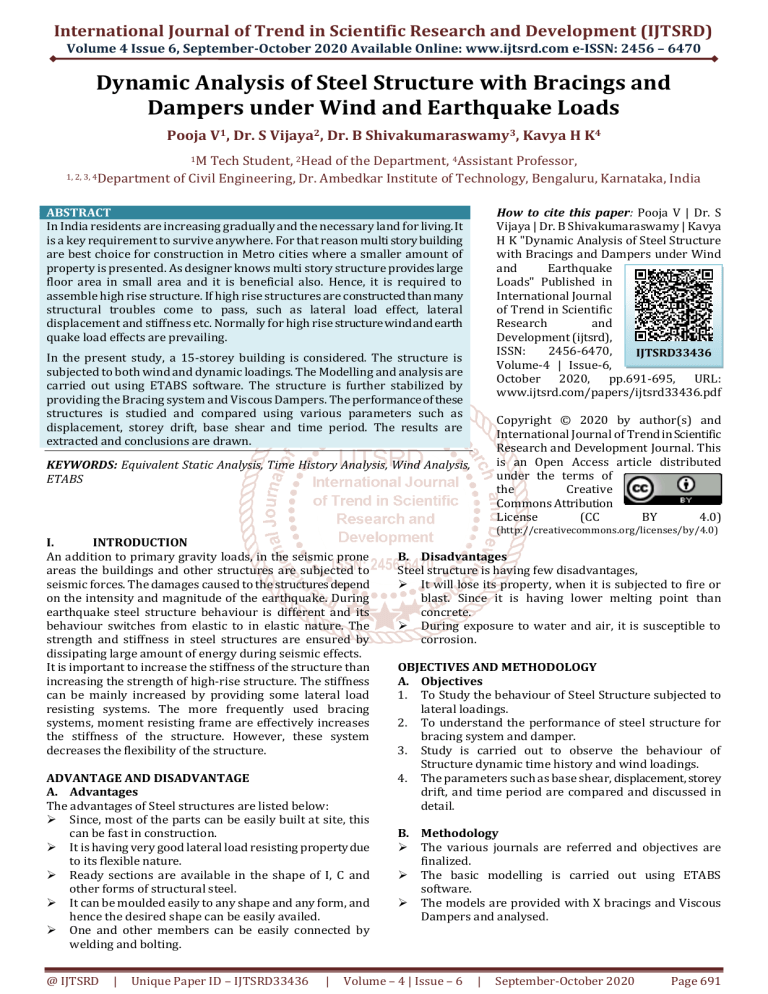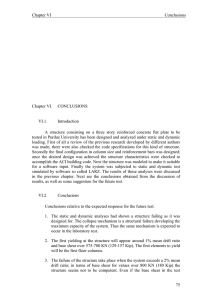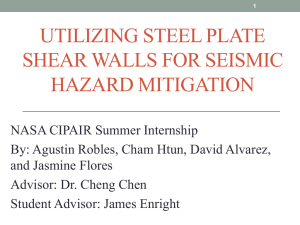
International Journal of Trend in Scientific Research and Development (IJTSRD)
Volume 4 Issue 6, September-October 2020 Available Online: www.ijtsrd.com e-ISSN: 2456 – 6470
Dynamic Analysis of Steel Structure with Bracings and
Dampers under Wind and Earthquake Loads
Pooja V1, Dr. S Vijaya2, Dr. B Shivakumaraswamy3, Kavya H K4
1M
Tech Student, 2Head of the Department, 4Assistant Professor,
1, 2, 3, 4Department of Civil Engineering, Dr. Ambedkar Institute of Technology, Bengaluru, Karnataka, India
ABSTRACT
In India residents are increasing gradually and the necessary land for living. It
is a key requirement to survive anywhere. For that reason multi story building
are best choice for construction in Metro cities where a smaller amount of
property is presented. As designer knows multi story structure provides large
floor area in small area and it is beneficial also. Hence, it is required to
assemble high rise structure. If high rise structures are constructed than many
structural troubles come to pass, such as lateral load effect, lateral
displacement and stiffness etc. Normally for high rise structure wind and earth
quake load effects are prevailing.
How to cite this paper: Pooja V | Dr. S
Vijaya | Dr. B Shivakumaraswamy | Kavya
H K "Dynamic Analysis of Steel Structure
with Bracings and Dampers under Wind
and
Earthquake
Loads" Published in
International Journal
of Trend in Scientific
Research
and
Development (ijtsrd),
ISSN:
2456-6470,
IJTSRD33436
Volume-4 | Issue-6,
October 2020, pp.691-695, URL:
www.ijtsrd.com/papers/ijtsrd33436.pdf
In the present study, a 15-storey building is considered. The structure is
subjected to both wind and dynamic loadings. The Modelling and analysis are
carried out using ETABS software. The structure is further stabilized by
providing the Bracing system and Viscous Dampers. The performance of these
structures is studied and compared using various parameters such as
displacement, storey drift, base shear and time period. The results are
extracted and conclusions are drawn.
Copyright © 2020 by author(s) and
International Journal of Trend in Scientific
Research and Development Journal. This
is an Open Access article distributed
under the terms of
the
Creative
Commons Attribution
License
(CC
BY
4.0)
KEYWORDS: Equivalent Static Analysis, Time History Analysis, Wind Analysis,
ETABS
I.
INTRODUCTION
An addition to primary gravity loads, in the seismic prone
areas the buildings and other structures are subjected to
seismic forces. The damages caused to the structures depend
on the intensity and magnitude of the earthquake. During
earthquake steel structure behaviour is different and its
behaviour switches from elastic to in elastic nature. The
strength and stiffness in steel structures are ensured by
dissipating large amount of energy during seismic effects.
It is important to increase the stiffness of the structure than
increasing the strength of high-rise structure. The stiffness
can be mainly increased by providing some lateral load
resisting systems. The more frequently used bracing
systems, moment resisting frame are effectively increases
the stiffness of the structure. However, these system
decreases the flexibility of the structure.
ADVANTAGE AND DISADVANTAGE
A. Advantages
The advantages of Steel structures are listed below:
Since, most of the parts can be easily built at site, this
can be fast in construction.
It is having very good lateral load resisting property due
to its flexible nature.
Ready sections are available in the shape of I, C and
other forms of structural steel.
It can be moulded easily to any shape and any form, and
hence the desired shape can be easily availed.
One and other members can be easily connected by
welding and bolting.
@ IJTSRD
|
Unique Paper ID – IJTSRD33436
|
(http://creativecommons.org/licenses/by/4.0)
B. Disadvantages
Steel structure is having few disadvantages,
It will lose its property, when it is subjected to fire or
blast. Since it is having lower melting point than
concrete.
During exposure to water and air, it is susceptible to
corrosion.
OBJECTIVES AND METHODOLOGY
A. Objectives
1. To Study the behaviour of Steel Structure subjected to
lateral loadings.
2. To understand the performance of steel structure for
bracing system and damper.
3. Study is carried out to observe the behaviour of
Structure dynamic time history and wind loadings.
4. The parameters such as base shear, displacement, storey
drift, and time period are compared and discussed in
detail.
B. Methodology
The various journals are referred and objectives are
finalized.
The basic modelling is carried out using ETABS
software.
The models are provided with X bracings and Viscous
Dampers and analysed.
Volume – 4 | Issue – 6
|
September-October 2020
Page 691
International Journal of Trend in Scientific Research and Development (IJTSRD) @ www.ijtsrd.com eISSN: 2456-6470
The analysis is carried out for static (Equivalent Static
Analysis), dynamic (Time History Analysis) and wind
analysis.
The results are extracted and discussed in detail. The
conclusions are drawn based on the study
II.
MODELLING
In the modelling a 15 Storey steel structure modelling has
been discussed. The basic models are created using the
below steps and the remaining models are prepared using
similar way.
Model 1 : Multi level Steel Structure.
Model 2 : Multi level Steel Structure with X Bracing System
at Corner.
Model 3 : Multi level Steel Structure with X Bracing System
at Middle.
Model 4 : Multi level Steel Structure with Viscous Damper
at Corner.
Model 5 : Multi level Steel Structure with Viscous Damper
at Middle.
The below steps explain the modelling procedure carried out
for modelling.
Finalizing Grid data & Storey data.
Defining - Materials
Defining Frame sections & area Sections.
Defining Load Cases.
Defining Mass source.
Draw Columns, slabs & drop slab.
Assigning support restrains.
Assigning Loads.
Analysis
Result Extraction.
The above procedure holds good for other models and
results are extracted in the same way as explained
below. Few of images are presented in the below
section, which are self-explanatory.
Fig 2:3D View
Table 1-Material Properties and Design Parameters
Sl.
Description
Data
No.
1.
Seismic Zone
III
2.
Seismic Zone Factor (Z)
0.16
3.
Importance Factor (I)
1.5
Response Reduction
4.
4
Factor (R)
5.
Damping Ratio
0.05
6.
Soil Type
Hard Soil (Type II)
7.
Height of the building
45m(15 Storey)
8.
Story to story Height
3.0 m
9.
Span Length
5m
10.
Column Size used
ISMB500
11.
Thickness of Slab
125mm
12.
Floor Finish
1.5KN/m2
13.
Live Load
4.0KN/m2
14.
Grade of Concrete (fck)
M35
Grade of Structural Steel
15.
Fe 350
(fys)
Grade of Reinforcing
16.
Fe 500
Steel (fyr)
RESULTS AND DISCUSSIONS
Graph1: Displacement vs. Storey in X Dir._ EQX
Fig 1: Plan View
From the graph above, it is seen that model 1 is having
highest displacement compared to all other models.
However, the displacement reduced drastically after the
introduction of dampers and bracings.
@ IJTSRD
|
Unique Paper ID – IJTSRD33436
|
Volume – 4 | Issue – 6
|
September-October 2020
Page 692
International Journal of Trend in Scientific Research and Development (IJTSRD) @ www.ijtsrd.com eISSN: 2456-6470
The model M4 is showing least displacement than other
models.
The drift values of all the models are within limiting range
and equal approximately
Graph2: Storey Drift vs. Storey in X Dir._ EQX
Drift values are found more in model M1. However, other
models possess same drift values
Graph 4: Displacement vs. Storey in X Dir._ EQX
From the graphs, time history results show similar
displacement for all the models. This is due to fact that, the
dynamic analysis works better for super tall structures
Graph 3: Base Shear_ EQX
All the base shear values are same. However, the model M2
is having little higher base shear values comparatively. The
base shear mainly depends on the mass of the structure. The
Additional mass of the structure is mainly due to bracings
only
Graph 5: Storey Drift vs. Storey in X Dir.-THX
@ IJTSRD
|
Unique Paper ID – IJTSRD33436
|
Graph 6: Base Shear_ THX
The base shear due to time history analysis shows the
capacity-based distribution of forces. It indicates that the
models having higher stiffness will attract higher base shear
values. And hence, the model M4 and Model M2 having
maximum base shear comparatively
Graph7: Displacement vs. Storey in X Dir._ WINDX
Volume – 4 | Issue – 6
|
September-October 2020
Page 693
International Journal of Trend in Scientific Research and Development (IJTSRD) @ www.ijtsrd.com eISSN: 2456-6470
From the graph above, it is seen that model 1 is having
highest displacement compared to all other models.
However, the displacement reduced drastically after the
introduction of dampers and bracings. The model M4 is
showing least displacement than other models.
Since, frequency depends on time period and inversely
proportional. The frequency value is found maximum in case
of model M4 and least in case of model 1.
Graph 8: Time Period vs. Modes
Graph 11: Drift vs. Storey in X Dir._ WINDX
The time period of the model 1 is more and found flexible
compared to other models. However, model M4 is more rigid
and exhibiting lesser time period values
Drift values are found more in model M1. However, other
models possess same drift values
Graph 9: Base Shear_ WINDX
The base shear values are same for all the models. It is due to
the fact that, base shear value depends on the amount of
wind force applied. Unless seismic force, it won’t depend on
inertial force and stiffness of the structure.
CONCLUSIONS
From the static Analysis, it is found that, the displacement
values are higher in case of model M1 with bare frame,
however, it is reducing up to 31% and 37% by providing
bracings and dampers respectively.
The drift values are higher for model M1. The drift
values are reducing for other models with bracings and
dampers. The drift values lesser in models with bracings
and dampers located at ends and it is little more in case
of drift values at middle.
The base shear values are similar for almost all the
models. However, the base shear of model 2 is more
comparatively.
Based on Time history analysis, the displacement of all
the models are almost similar. The models are having
very minor variations. Since, the structure is 15 Storeys,
the effect of dynamic analysis is also less. Hence no
much variation in difference in displacement among
other models.
The drift values are less for all the models and all models
are having drift values lesser than limiting.
The base shear values are higher in case of model 4 and
model 2. This is due to fact that, these two models are
having higher stiffness. In the time history analysis, the
models having more stiffness attract maximum base
shear values.
The effect of displacement is similar for static and wind
analysis. The maximum displacement is noticed In
model 1. However, it is reducing for bracings and
dampers system by 34% and 39.5% respectively.
The drift values are maximum in case of Model M1. The
values are reducing after the introduction of bracing and
damper systems. However, dampers and bracings
provided at exterior support at exhibiting better results
comparatively.
The base shear values of all the models in wind loading
are same. Since, the base shear depends only on applied
force in case of wind analysis.
Graph 10: Frequency vs. Modes
@ IJTSRD
|
Unique Paper ID – IJTSRD33436
|
Volume – 4 | Issue – 6
|
September-October 2020
Page 694
International Journal of Trend in Scientific Research and Development (IJTSRD) @ www.ijtsrd.com eISSN: 2456-6470
The modal analysis shows the models 4 is efficient, rigid
and higher stiffness compared to other models. The time
period value is more in model M1 than other models.
And hence lesser stiffness and higher flexibility.
The frequency of the structure is found maximum in
model M4 than other models and model M1 is showing
lowest frequency.
From the overall results it is found that, the dampers
provided at exterior end exhibits better performs than
all other models. However, the next efficient is the
model M2 with bracing at exterior location.
From the results it also proves that, location of bracings
and dampers matters. There is a difference in the
results. Even though, the models provided with dampers
at middle portion is exhibiting higher Displacement than
bracing provided at exterior locations.
[3] B. Ravali, P. Poluraju, “Seismic Analysis of Industrial
Structure Using Bracings and Dampers”.
Future Scope:
The Structures can be analysed for further high-rise
structure and results can be interpreted
Different time history files can be compared for better
results.
Pushover analysis can be adopted to assess the localized
failures
[8] Dhanaraj M. Patil, Keshav K. Sangle, “Seismic Behaviour
of Different Bracing Systems in High Rise 2-D Steel
Buildings”.
REFERENCES
[1] Farshad Taiyaria,1, Federico M. Mazzolanib, Saman
Bagheria, “Damage-based optimal design of friction
dampers in multistory chevron braced steel frames.”.
[4] Jalaeefar & B. Asgarian, “Seismic Assessment of
Innovative Hybrid Bracing System Equipped with
Shape Memory Alloy”.
[5] Huseyin Cetin* and Ersin Aydin**, “A New Tuned Mass
Damper Design Method based on Transfer Functions”.
[6] Domenico Altieria, Enrico Tubaldib, Edoardo Patellia, ∗
Andrea Dall’Astac, “Assessment of optimal design
methods of s”.
[7] Jenn-Shin Hwanga,b,∗, Chun-Hsiang Tsaic, Shiang-Jung
Wangd, Yin-Nan Huange,b, “Experimental study of RC
building structures with supplemental s and lightly
reinforced walls”.
[9] Adithya. M1, Swathi rani K.S2, Shruthi H K3, Dr.
Ramesh B.R4, “Study on Effective Bracing Systems for
High Rise Steel Structures”.
[10] Sachin Dhiman1, Mohammed Nauman2, Nazrul Islam3,
“Behaviour of Multistory Steel Structure with Different
Types of Bracing Systems (A Software Approach)”.
[11] Ashish Sadh1, Ankit Pal2, “A Literature Study of Wind
Analysis on High Rise Building”.
[2] Piero Colajanni and Maurizio Papia, “Seismic response
of braced frames with and without friction dampers”.
@ IJTSRD
|
Unique Paper ID – IJTSRD33436
|
Volume – 4 | Issue – 6
|
September-October 2020
Page 695






